Stonehenge, astronomical observatory of the neo-Ilitic
Stonehenge is located on the Salisbury Plain, about 100 kilometres from London. There are impressive rocks of between 2 and 35 tons, forming the most beautiful construction of the Neolithic.

Formed by such a peculiar architecture, the stories and legends about Stonehenge are of old. According to a legend written by Geofrefrey Monmouth, who lived in the Middle Ages, the construction was a gathering of giants turned into stone. That is why he was called the Dance of the Giants. The same man also left a legend, according to which the stones were transported by the magician Merlin from Ireland to celebrate a terrible funeral of the Bretons. The charm of the mystery of Stonehenge also hit the English king James I. In 1620, King Jaime commissioned the architect Iñigo Jones to investigate the stone complex, although archaeology, as a line of research, has not yet been created. According to the architect Jones, the set of stones was a monument dedicated to heaven by the Romans in the year 79. Although the king was satisfied, his architect fell short, as the set of stones of Stonehenge was thousands of years old for Roman times.
XVII. Another 20th century researcher, John Aubrey, decided that the monument was built by druids. The researchers of the time valued Aubrey's theory, but they were wrong, as he was old Stonehengen for the times of the druids. However, as a consequence of this theory, the mystery of the stones of the Salisbury plain was related to magic. That the stones cured diseases, that the problems of having children were solved if I slept with the couple, which was the place of the devil….
Mystery XX. It began to become clear in the early years of the 20th century and clarity did not come from the hand of archaeology, but from astronomy. In 1901, astronomer Sir Norman Lockyer was able to verify that in the summer solstice he stood by the stone of the altar and observing the frontal stone, of reference, the sunrise was perfectly visible, that is, the solar temple of Stonehenge.

According to Locky's calculations, the solar temple was built 1,800 years before Christ. Subsequent estimates using carbon 14 indicate that Stonehenge was built in the year 2,800 BC. Therefore, the building could not be Assyrian, neither Mycenaean nor Greek, and today it is believed that it was built by a Neolithic civilization of prefix origin.
However, the role of rock groups is better known today. Just as the stone of the altar marks the sunrise in the summer solstice, the menhirs located in the center mark the sunrise and entrance of the sun and moon in the winter solstices. Therefore, Stonehenge is an astronomical observatory that can also be used as a calculator to predict sun and moon eclipses. But it is a place of worship to the sun and the moon. That is why it was sacred and in view of the traces that have come out of the ground it can be deduced that it was a place to commit several rites.
You can see the different structures of Stonehenge:
- Dolmens: two vertical stones on which one rests. Standing stones weigh 25 tons and lying 7.
- Menhires: standing stones.
- Cromlechs: circles made with menhirs.
In the main section there are 30 columns covered by 17 stones. This stone circle has a diameter of 29.6 meters. Three meters further inland there is a section formed by 60 menhirs 2 meters high. Apparently, before they were covered with overlapping stones, but now there are only 20. Further inland there are five large dolmens, the largest in the center of 8 meters and four smaller on the sides. Inside there are 19 menhir of about 3 meters. Finally, in the center is the stone of the altar, 4.8 meters high. Around all this -on the turn, more specifically, - several holes and hills of land, and beyond -37 meters- a reference stone, a stone of 35 tons. How was it built?

The megalithic ensemble of the Salisbury Plain reflects an enormous planning and construction effort. It seems that it is not the result of the planning carried out from the beginning, since in 40 generations different forms were given. According to current archaeologists, three main construction phases were carried out in Stoneheng. The first phase took place 2,800 years before Christ. The central circle was built, the reference stone and stones indicating the four seasons were located. Therefore, the main sun and moon indicators were located for the first phase.
The second phase corresponds to the year 2,100 BC. Stones from the second section were placed - according to all the data, brought from coast to coast from Wales at first and then with rollers and ropes. To lift the stones first the hole was made, then, little by little, with the levers, the ropes and the beams, they raised their weights until they forced them to put them in. The outer holes of the structure indicate that the builders also intended to insert more stones, but could not finish the work.
The last phase, before the 1,500 years of Christ, consisted in the placement of circular stones and altar stone, also from the mountains of Wales. Thus this ancient astronomical observatory was made.
Despite its elegance, Stonehenge is not the only Neolithic astronomical ensemble in the world, but exists in Europe, Egypt and the United States of America and Mexico. Are these sets also precarious? The question is not comfortable for archaeologists and historians, since if this were so, among other things, it would mean that the Atlantic crossed much earlier than is believed.
Published in 7
Buletina
Bidali zure helbide elektronikoa eta jaso asteroko buletina zure sarrera-ontzian











